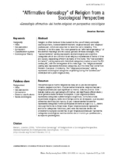Mostrar el registro sencillo del ítem
“Affirmative genealogy” of religion from a sociological perspective
| dc.creator | Beriain Rázquin, Josetxo | es_ES |
| dc.date.accessioned | 2016-12-12T09:37:10Z | |
| dc.date.available | 2016-12-12T09:37:10Z | |
| dc.date.issued | 2015 | |
| dc.identifier.issn | 0210-5233 (Print) | |
| dc.identifier.issn | 1988-5903 (Electronic) | |
| dc.identifier.uri | https://hdl.handle.net/2454/22977 | |
| dc.description | Enlace a la versión en castellano: https://hdl.handle.net/2454/22978 | es_ES |
| dc.description.abstract | Pensamos que el hecho religioso se basa en el uso de conceptos binarios (sagrado/profano, trascendente/inmanente, religioso/secular y religioso/postsecular) que significan lo mismo. Esto es un error. Este trabajo realiza una «genealogía afirmativa» del signifi cado diferenciado y de la génesis social de tales conceptos. El par sagrado/profano representa categorías epistemológico-cognitivas, comunes a toda experiencia religiosa, tanto en el tiempo como en el espacio, que separan diferentes dominios del mundo. El par «trascendente/inmanente» representa categorías históricas forjadas en torno al siglo V a. C., dentro del surgimiento de la Edad Axial. El par religioso/secular representa asimismo categorías históricas, pero esta vez nacidas dentro del cristianismo europeo occidental. El par religioso/postsecular representa categorías sociológicas nacidas dentro de un mundo ya «postsecular», aunque no postreligioso. | en |
| dc.description.abstract | Religion is often believed to be based on the use of binary concepts (sacred/profane, transcendent/immanent, religious/secular and religious/ postsecular), which are assumed to have the same meaning. This, however, is not the case. This work presents an “affirmative genealogy” of the distinct meanings and the social genesis of these concepts. The “sacred/profane” pairing represents epistemological and cognitive categories which are common to all religious experiences in terms of time and space, separating different domains of the world. The “transcendent/ immanent” pairing represents historical categories created around the 5th century BC, with the emergence of the Axial Age. The “religious/secular” pairing also represents historical categories, but this time they come from Western European Christianity. The “religious/postsecular” pairing represents sociological categories originating during the “postsecular” world (but not a post-religious one). | en |
| dc.format.extent | 18 p. | |
| dc.format.mimetype | application/pdf | en |
| dc.language.iso | eng | en |
| dc.publisher | Centro de Investigaciones Sociológicas | es_ES |
| dc.relation.ispartof | Reis. Revista Española de Investigaciones Sociológicas. Nº 151, July - September 2015, pp. 3-20 | es_ES |
| dc.subject | Religiosidad | es_ES |
| dc.subject | Ritos | es_ES |
| dc.subject | Secularización | es_ES |
| dc.subject | Simbolismo | es_ES |
| dc.subject | Sistema clasificatorio | es_ES |
| dc.subject | Teoría sociológica | es_ES |
| dc.subject | Religiosity | en |
| dc.subject | Rites | en |
| dc.subject | Secularization | en |
| dc.subject | Symbolism | en |
| dc.subject | Classification system | en |
| dc.subject | Sociological theory | en |
| dc.title | “Affirmative genealogy” of religion from a sociological perspective | en |
| dc.title.alternative | «Genealogía afirmativa» del hecho religioso en perspectiva sociológica | es_ES |
| dc.type | Artículo / Artikulua | es |
| dc.type | info:eu-repo/semantics/article | en |
| dc.contributor.department | Sociología | es_ES |
| dc.contributor.department | Soziologia | eu |
| dc.rights.accessRights | Acceso abierto / Sarbide irekia | es |
| dc.rights.accessRights | info:eu-repo/semantics/openAccess | en |
| dc.identifier.doi | 10.5477/cis/reis.151.3 | |
| dc.relation.publisherversion | https://dx.doi.org/10.5477/cis/reis.151.3 | |
| dc.type.version | Versión publicada / Argitaratu den bertsioa | es |
| dc.type.version | info:eu-repo/semantics/publishedVersion | en |


